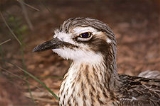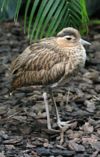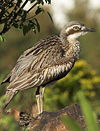
Stone-curlew
Encyclopedia
The Stone-curlews, also known as Dikkops or Thick-knees are a group of largely tropical birds in the family Burhinidae. Despite the group being classified as waders, most species have a preference for arid or semi-arid habitats. They are found worldwide within the tropical zone, with some species also breeding in temperate Europe
and Australia
.
They are medium to large birds with strong black or yellow black bills, large yellow eyes—which give them a reptilian appearance—and cryptic plumage. The names Thick-knee and Stone-curlew are both in common use, the preference among authorities for one term or the other varying from year to year. The term Stone-curlew owes its origin to the broad similarities with true curlew
s (which are not closely related). Thick-knee refers to the prominent joints in the long yellow or greenish legs and apparently originated with a name coined in 1776 for B. oedicnemus, the Thick-kneed Bustard.
They are largely nocturnal, particularly when singing their loud wailing songs, which are reminiscent of true curlews.
The diet consists mainly of insect
s and other invertebrates. Larger species will also take lizards and even small mammals.
Most species are sedentary, but the Stone Curlew
is a summer migrant
in the temperate European part of its range, wintering in Africa
.
The nine species are:
Europe
Europe is, by convention, one of the world's seven continents. Comprising the westernmost peninsula of Eurasia, Europe is generally 'divided' from Asia to its east by the watershed divides of the Ural and Caucasus Mountains, the Ural River, the Caspian and Black Seas, and the waterways connecting...
and Australia
Australia
Australia , officially the Commonwealth of Australia, is a country in the Southern Hemisphere comprising the mainland of the Australian continent, the island of Tasmania, and numerous smaller islands in the Indian and Pacific Oceans. It is the world's sixth-largest country by total area...
.
They are medium to large birds with strong black or yellow black bills, large yellow eyes—which give them a reptilian appearance—and cryptic plumage. The names Thick-knee and Stone-curlew are both in common use, the preference among authorities for one term or the other varying from year to year. The term Stone-curlew owes its origin to the broad similarities with true curlew
Curlew
The curlews , genus Numenius, are a group of eight species of birds, characterised by long, slender, downcurved bills and mottled brown plumage. They are one of the most ancient lineages of scolopacid waders, together with the godwits which look similar but have straight bills...
s (which are not closely related). Thick-knee refers to the prominent joints in the long yellow or greenish legs and apparently originated with a name coined in 1776 for B. oedicnemus, the Thick-kneed Bustard.
They are largely nocturnal, particularly when singing their loud wailing songs, which are reminiscent of true curlews.
The diet consists mainly of insect
Insect
Insects are a class of living creatures within the arthropods that have a chitinous exoskeleton, a three-part body , three pairs of jointed legs, compound eyes, and two antennae...
s and other invertebrates. Larger species will also take lizards and even small mammals.
Most species are sedentary, but the Stone Curlew
Stone Curlew
The Stone Curlew, Eurasian Thick-knee, or Eurasian Stone-curlew Burhinus oedicnemus is a northern species of the Burhinidae bird family....
is a summer migrant
Bird migration
Bird migration is the regular seasonal journey undertaken by many species of birds. Bird movements include those made in response to changes in food availability, habitat or weather. Sometimes, journeys are not termed "true migration" because they are irregular or in only one direction...
in the temperate European part of its range, wintering in Africa
Africa
Africa is the world's second largest and second most populous continent, after Asia. At about 30.2 million km² including adjacent islands, it covers 6% of the Earth's total surface area and 20.4% of the total land area...
.
Species
The nine species are:
| Picture | Name | Binomial name |
|---|---|---|
| Eurasian Stone-curlew | Burhinus oedicnemus | |
| No picture | Senegal Thick-knee Senegal Thick-knee The Senegal Thick-knee, Burhinus senegalensis, is a Stone-curlew, a group of waders in the family Burhinidae.It is a resident breeder in Africa between the Sahara and the equator, and in the Nile valley.... |
Burhinus senegalensis |
 |
Water Thick-knee Water Thick-knee The Water Thick-knee is a species of bird in the Burhinidae family.It is found in Angola, Botswana, Burkina Faso, Burundi, Cameroon, Central African Republic, Republic of the Congo, Democratic Republic of the Congo, Ivory Coast, Ethiopia, Gabon, Ghana, Kenya, Liberia, Malawi, Mozambique, Namibia,... |
Burhinus vermiculatus |
 |
Spotted Thick-knee Spotted Thick-knee The Spotted Thick-knee, Burhinus capensis, also known as the Spotted Dikkop or Cape Thick-knee, is a stone-curlew in the family Burhinidae.- Description :... |
Burhinus capensis |
 |
Double-striped Thick-knee Double-striped Thick-knee The Double-striped Thick-knee, Burhinus bistriatus, is a Stone-curlew, a group of waders in the family Burhinidae.It is a resident breeder in Central and South America from southern Mexico south to Colombia, Venezuela and northern Brazil... |
Burhinus bistriatus |
| Peruvian Thick-knee Peruvian Thick-knee The Peruvian Thick-knee is a species of bird in the Burhinidae family.It is found in Chile, Ecuador, and Peru.... |
Burhinus superciliaris | |
 |
Bush Stone-curlew Bush Stone-curlew The Bush Stone-curlew or Bush Thick-knee is a large, ground-dwelling bird endemic to Australia... |
Burhinus grallarius (formerly B. magnirostris, the Bush Thick-knee). |
| Great Stone-curlew | Esacus recurvirostris | |
 |
Beach Stone-curlew Beach Stone-curlew The Beach Stone-curlew, Esacus giganteus also known as Beach Thick-knee is a large, ground-dwelling bird that occurs in Australasia, the islands of South-east Asia... |
Esacus giganteus (formerly E. magnirostris, the Beach Thick-knee). |
External links
- Thick-knees videos on the Internet Bird Collection

